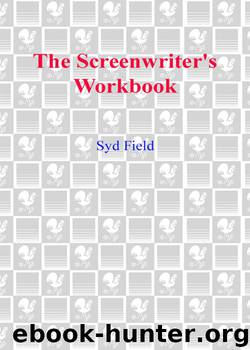The Screenwriter's Workbook (Revised Edition) by Field Syd

Author:Field, Syd [Field, Syd]
Language: eng
Format: epub
ISBN: 9780307497727
Publisher: Random House Publishing Group
Published: 2008-12-18T05:00:00+00:00
Structuring Act I
Howard: “This is not the finish line, my friends. This is the start of the race. The future is the finish line….”
—Gary Ross
Seabiscuit
The hardest thing about writing is knowing what to write. The second hardest is figuring out the best way to write it.
That's what is coming up next in the screenwriting process. As we shall see, the blank sheet of paper is not only the beginning of a new journey, but also the end of a journey. We've gone from the necessary preparation needed to write the screenplay to actually getting ready to write the screenplay.
Up until this point we've taken a three-sentence idea and expanded it into a four-page treatment focusing on dramatic structure. We've isolated the ending, the beginning, Plot Point I, and Plot Point II. We've done character biographies, defined our character's dramatic need, determined his or her point of view and attitude and whether he or she has changed or gone through some kind of emotional transformation in life. We've done any required research on the subject or the historical times in which he or she lived.
So, now what? What's the next step in the screenwriting process?
Structuring Act I.
Now that we have the form of the story line, we can begin to lay out the content. Act I is a unit, or block, of dramatic action. It begins on page one and goes to the plot point at the end of Act I. It is approximately thirty pages long, and held together with the dramatic context known as the Set-Up. We have to set up our story, introduce our characters, define their relationships, and establish the dramatic premise, what the story is about. The context, remember, is the space that holds something in place, like the space inside a glass that holds the content in place. The context doesn't change; only the content changes.
Act I holds the content—the characters, dialogue, locations, scenes, sequences—in place. Everything in this Act I unit of dramatic action sets up the story: the characters, the situation, the dramatic premise. That's why Act I is so important; everything relates to setting up your story and characters. It is a unit of dramatic action that takes us from the beginning to the Plot Point at the end of Act I. It is a whole as well as a part, therefore you must “design” it carefully.
Aristotle talks about the three unities of dramatic action: time, place, and action. So this first unit of action, Act I, establishes what the story is about and who it's about. Seabiscuit is a good example. Here, we have a true story about four characters who are influenced by the times they live in, the Great Depression of the 1930s in America. They worked together as a team to create a story that inspired an entire nation. The first thing Gary Ross, the writer-director, had to establish was the time in which the story takes place. The story begins with a shot of the Model T
Download
This site does not store any files on its server. We only index and link to content provided by other sites. Please contact the content providers to delete copyright contents if any and email us, we'll remove relevant links or contents immediately.
The Kite Runner by Khaled Hosseini(5088)
Gerald's Game by Stephen King(4584)
Dialogue by Robert McKee(4326)
The Perils of Being Moderately Famous by Soha Ali Khan(4171)
The 101 Dalmatians by Dodie Smith(3455)
Story: Substance, Structure, Style and the Principles of Screenwriting by Robert McKee(3399)
The Pixar Touch by David A. Price(3369)
Confessions of a Video Vixen by Karrine Steffans(3247)
How Music Works by David Byrne(3191)
Fantastic Beasts: The Crimes of Grindelwald by J. K. Rowling(2996)
Harry Potter 4 - Harry Potter and The Goblet of Fire by J.K.Rowling(2993)
Slugfest by Reed Tucker(2946)
The Mental Game of Writing: How to Overcome Obstacles, Stay Creative and Productive, and Free Your Mind for Success by James Scott Bell(2847)
4 - Harry Potter and the Goblet of Fire by J.K. Rowling(2657)
Screenplay: The Foundations of Screenwriting by Syd Field(2576)
The Complete H. P. Lovecraft Reader by H.P. Lovecraft(2514)
Scandals of Classic Hollywood: Sex, Deviance, and Drama from the Golden Age of American Cinema by Anne Helen Petersen(2467)
Wildflower by Drew Barrymore(2447)
Robin by Dave Itzkoff(2387)
